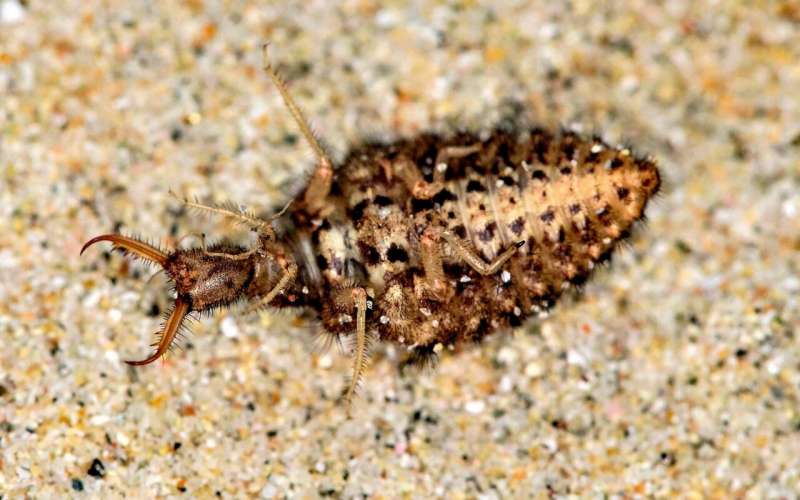
An antlion larva (Euroleon nostras) plays dead. Photo credit: Nigel R Franks, University of Bristol
A study led by scientists at the University of Bristol shows what animals do after playing dead to avoid being killed by a predator and what the context of this behavior is. The work was published in PLoS ONE.
Many animals remain motionless after contact with a predator as a last defense measure.
This behavior is so common that it is reflected in expressions such as “playing dead.” It is even said to occur in humans under extreme circumstances.
In previous studies conducted by the same team with antlion larvae, scientists found that they became motionless when handled individually.
At some point the larvae had to be weighed, which can be very difficult with such small insects. As they move around on the scales, determining their mass can be a challenge.
However, if the antlion larvae were dropped very carefully onto the scales of a balance, they remained in place longer than was necessary for their weight to be accurately recorded.
Emeritus Professor Nigel Franks of the University of Bristol’s School of Biological Sciences, who led the study, said: “We decided to investigate this so-called ‘dead-playing’ behaviour and found that the length of time individual antlions stay in one place is completely unpredictable for each individual.”
“This is confirmed when you look at the duration of immobility after contact in large numbers of antlions. Such data show an exponential distribution. So, just like radioactive atoms, it is unpredictable when an individual will change its state, but the population pattern is perfectly predictable.”
The study shows that the behavior of antlions hiding in plain sight in this way is probably adaptive, since a predator that has picked up and then dropped an antlion larva cannot know how long it will have to wait until its potential victim moves again and becomes a recognizable prey item again. In fact, one of the antlions observed remained completely motionless for over an hour.
Although it is impossible to predict when a motionless antlion will come back to life, this does not necessarily mean that the predator has left the scene to search for alternative prey.
The team’s next question was what animals do after playing dead. In the new study, they show that antlions’ behavior depends on the situation they find themselves in.
Antlion larvae are burrowing animals and may seek shelter by diving into the crumbly substrate where they normally build their burrows. However, it is entirely possible for a predator to drop an antlion onto hard substrate from which it cannot escape.
By using sophisticated automated video tracking of the intermittent movement of individual antlions on different surfaces, researchers have found that the behavior of an antlion after its immobility phase ends depends on the escape strategies available.
Professor Franks added: “Our study may be the first to establish what animals do after they play dead. And we show that their behaviour depends on context. It’s a trade-off. So our work opens up the possibility of studying the afterlife in large numbers of animals that play dead, display thanatosis or, as we prefer to call it, post-contact immobility.”
Further information:
“In search of safety: movement dynamics after immobility after contact”, PLoS ONE (2024).
Provided by the University of Bristol
Quote: Life after (feigned) death: Study discovers context-dependent behavior in antlions after “playing dead” (22 August 2024), accessed on 22 August 2024 from https://phys.org/news/2024-08-life-feigned-death-context-behavior.html
This document is subject to copyright. Except for the purposes of private study or research, no part of it may be reproduced without written permission. The contents are for information purposes only.

